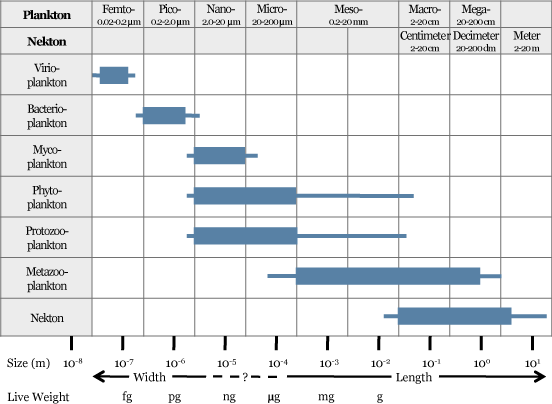Plankton
What is plankton anyway?
Almost everyone has heard of plankton, but what is plankton, and what does the word really mean? I think the easiest way to understand what the word means is to examine where it comes from. Plankton comes from the Greek word planktos, which is translated to wanderer or drifer. Thus plankton are organisms that drift in the water. This is not to say that plankton cannot swim, and in fact some plankton are adept swimmers that can move many body lengths in a short amount of time, however, their ultimate distribution is controlled by the motions of the water, which is stronger than the organisms themselves overall.
Most of my work relates to marine plankton, though lakes, streams, and nearly any aquatic environment you can think of contains some plankton. Many of the descriptions and examples listed here are about marine plankton because it is what I am most familiar with, but freshwater plankton is equally important to those ecosystems.
There are a number of different ways to classify plankton, which are described below:
Some of my personal favorite plankton are also listed at the bottom of the page (click here to go there now).
Organismal Divisions
- Phytoplankton are plant plankton. Like all plants, these organisms are autotrophic meaning they use the sun as their only energy source through the process of photosynthesis. This process converts carbon dioxide (CO2) into simple sugars, which can be then converted into nearly any other molecule the organism needs to live, or broken down as food. Phytoplankton are considered primary producers which puts them at the base of the food web, since their only source of ‘food’ is the sun.
- Zooplankton are animal plankton. They are heterotrophic, meaning they eat by ingesting objects they encounter in the water, including phytoplankton, other zooplankton, and detritus. Zooplankton encompasses many different groups of animals that range in size from microscopic crustaceans to jellyfish up to a few feet across. Because many zooplankton can feed on tiny phytoplankton, and those zooplankton in turn are eaten by larger zooplankton, fish, or even whales, zooplankton are an important link in the food web between primary producers and the higher trophic levels.
- Bacterioplankton are bacterial and archael plankton. They are single celled organisms that can be categorized as bacteria and archaea because they do not contain a true nucleus or membrane bound organelles. Some of the bacterioplankton can be autotrophic and thus included in the phytoplankton.
Life History Divisions
- Meroplankton are organisms that spend only part of their life in the plankton. These include both members of the phytoplankton and the zooplankton. Often holoplankton have an early stage of the life history which is planktonic, followed by a stage during which the plankton metamorphoses into a organism which settles to a surface. This includes species of seaweed and kelp, and also crabs, lobsters, clams, oysters, and worms among many others.
- Holoplankton are organisms that spend their entire lives in the plankton. This includes both phytoplankton and zooplankton, and covers the whole spectrum of plankton sizes and types.
Size Divisions
A system of size classification for plankton that is widely used today was developed and published by John Sieburth and others in 1978, and a figure from that work is included below. Note that different organisms are listed with the most appropriate size ranges:

Adapted from Sieburth et. al. 1978
John McN. Sieburth, Victor Smetacek, Jurgen Lenz. 1978. Pelagic Ecosystem Structure: Heterotrophic Compartments of the Plankton and Their Relationship to Plankton Size Fractions. Limnology and Oceanography, Vol. 23, No. 6. (Nov., 1978), pp. 1256-1263.
Some of my favorite plankton. . .
Copepods are tiny holoplanktonic crustaceans (Phylum Arthropoda, Subphylum Crustacea, Class Copepoda) that generally fall into the mesoplankton and macroplankton categories (0.2-200 mm in length). Their name means oar-foot and is given due to the fact that when they swim, all of their hind legs move seemingly in concert or in sequence like the oars of boat. They are probably the most abundant multicellular organism on the planet and are an extremely diverse group of animals. Most of my work focuses on one order of copepods, the Calanoida, which are primarily marine pelagic species. Many of the Calanoida are important in coastal, estuarine, and open ocean food webs, providing significant links between the phytoplankton (algae) and commercially important species of fish. Understanding how these linkages affect energy transfer between primary producers (plants) and higher trophic levels is of utmost importance for managing our marine resources. Not to mention it can be pretty fascinating stuff.
Diatoms are single celled Phytoplankton that are distinguished from other phytoplankton primarily by their silica shell, or frustule. Species are determined by the shapes and patterns present in the frustule, which can be extremely intricate and beautiful. There are two main types of diatoms, pennate and centric. Pennate diatoms have bilateral symmetry, whereas centric diatoms have radial symmetry. Many diatoms can form chains of up to hundreds or thousands of cells. Diatoms have a unique reproductive process whereby they normally reproduce asexually, but can undergo sexual reproduction. During asexual reproduction, the new cells are formed by the splitting of the frustule into two halves, with the new frustule built inside of the original part of the frustule. Thus, the average cell size of a population will decrease over time until some critical size is reached, or some other signal occurs, and the cells then begin to reproduce sexually and cell size increases again. During the spring in much of the temperate coastal ocean and throughout most of the North Atlantic, diatoms can form massive blooms that clog fishing nets and gills of fish, but also provide a tremendous amount of food for the herbivores of the ocean. |
